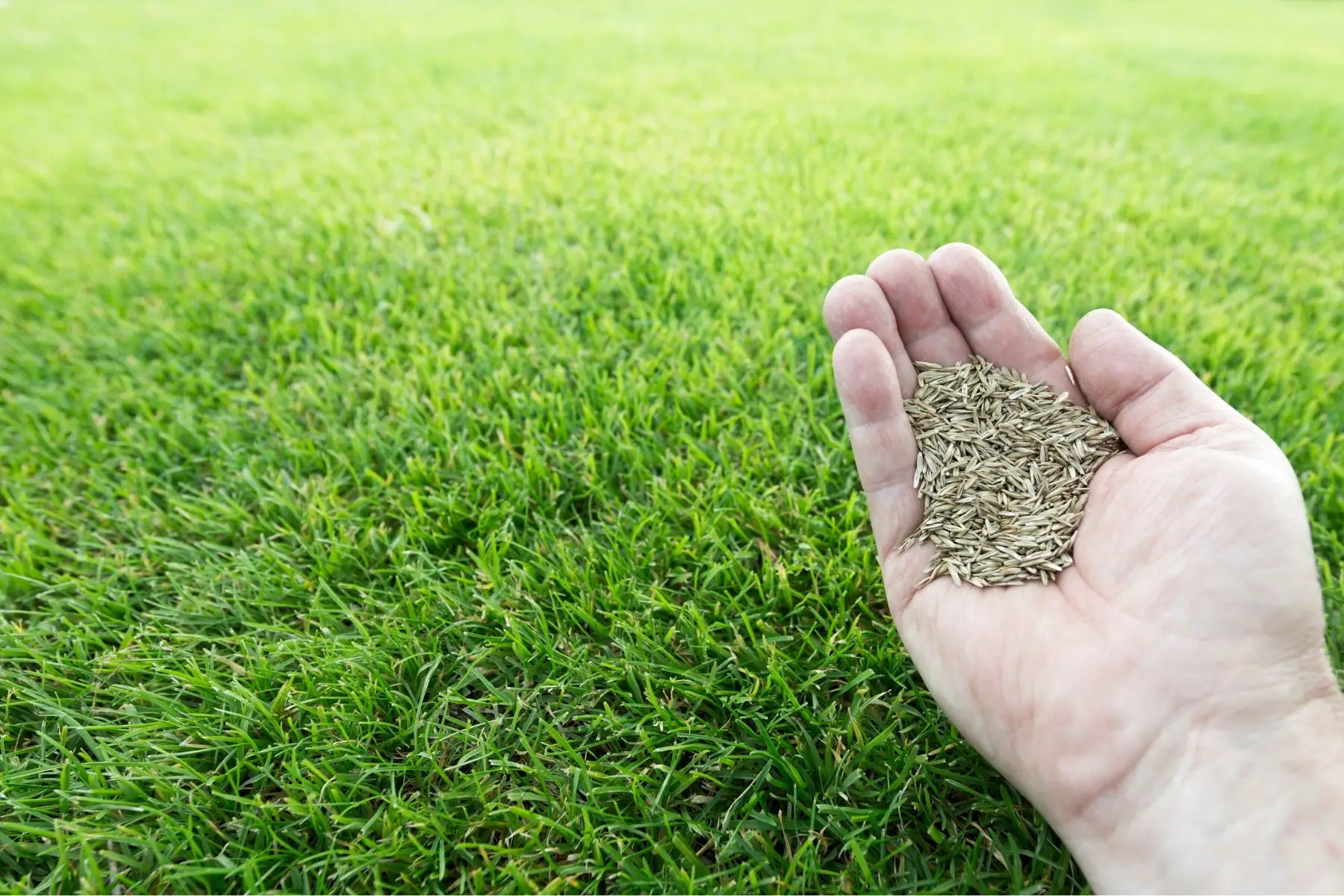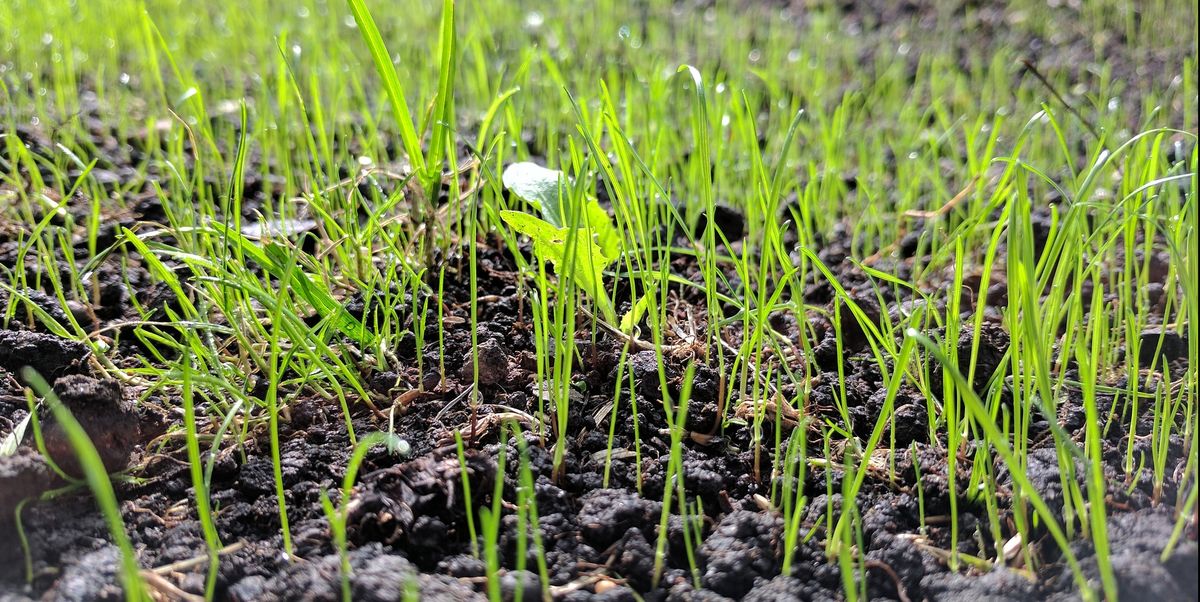Home>Gardening Basics>Getting Started>Why Do Weeds Grow In Grass


Getting Started
Why Do Weeds Grow In Grass
Modified: January 22, 2024
Learn the reasons why weeds tend to grow in grass and discover effective tips for getting started on preventing and eliminating them.
(Many of the links in this article redirect to a specific reviewed product. Your purchase of these products through affiliate links helps to generate commission for Chicagolandgardening.com, at no extra cost. Learn more)
Table of Contents
Introduction
Welcome to our comprehensive guide on why weeds grow in grass and how to tackle this common issue. If you have a lawn or any grassy area, you’ve probably encountered the persistent and unwanted presence of weeds. Weeds are simply plants that grow in places where they are not desired, and they often compete with grass for nutrients, water, and sunlight.
Understanding why weeds grow in grass is essential to effectively manage and maintain a healthy, weed-free lawn. In this guide, we will explore the role of weeds in grass, the factors that contribute to their growth, common types of weeds found in grass, the problems they can cause, and finally, we will provide you with tips and strategies on how to prevent and control weed growth.
It’s important to note that some weeds may have beneficial properties or be desirable in certain contexts, like in a wildflower meadow or as a food source for wildlife. However, when it comes to maintaining a well-maintained lawn or grassy area, most weeds are considered undesirable and require attention.
Dealing with weeds in your grass not only improves the aesthetic appeal of your lawn, but it also helps promote healthy growth and development of your desired grass species. By learning more about weeds and how to manage them, you can establish a more vibrant, lush, and weed-free environment.
So let’s dive in and explore the various aspects of weed growth in grass and equip ourselves with the knowledge and strategies needed to win the battle against these pesky invaders.
The Role of Weeds in Grass
Weeds play a significant role in the ecosystem, and while they may be considered nuisances in grass, they serve various purposes. Understanding their role is crucial in effectively managing and minimizing their presence.
One of the primary roles of weeds in grass is to indicate the health and condition of the soil. Different types of weeds have specific preferences for soil pH, moisture levels, and nutrient content. By observing the types of weeds growing in your grass, you can gain insight into the soil’s characteristics and make appropriate adjustments.
Additionally, weeds can provide initial ground cover when the grass is thin or damaged. They act as soil stabilizers, preventing erosion and reducing soil compaction. This can be particularly beneficial during the initial stages of lawn establishment or after disturbances such as construction or heavy foot traffic.
In some cases, certain weeds can also attract beneficial insects that help with pollination or act as natural predators for harmful insect pests. They can contribute to a more diverse and balanced ecosystem by offering alternative food sources and habitat for wildlife.
However, despite these potential benefits, the presence of weeds in grass can have several negative impacts. Weeds often compete with grass for essential resources such as water, sunlight, and nutrients. They can outcompete the grass, leading to thinning of the turf and a decline in its quality and appearance.
Furthermore, weeds can create an uneven texture in the grass and make it difficult to mow or maintain the lawn effectively. Their presence can also hinder the growth and development of desired grass species, preventing a uniform and healthy-looking lawn.
Ultimately, while weeds may have some ecological value, they can significantly impact the aesthetics and overall health of grass. It is important to strike a balance between promoting biodiversity and maintaining a well-maintained and weed-free lawn.
Now that we understand the role of weeds in grass, let’s explore the factors that contribute to their growth and proliferation.
Factors Contributing to Weed Growth in Grass
Weeds are resilient plants that can thrive in various conditions, which is why they tend to grow in grassy areas. Understanding the factors that contribute to weed growth in grass can help us develop effective strategies for prevention and control.
1. Lack of Proper Lawn Care:
A poorly maintained lawn provides an open invitation for weeds to take over. Neglecting regular mowing, irrigation, and fertilization can weaken the grass, creating opportunities for weeds to establish and flourish.
2. Inadequate Soil Conditions:
The condition of the soil plays a significant role in weed growth. Compacted soil, poor drainage, and nutrient deficiencies can weaken the grass, making it less competitive against weeds. Additionally, imbalanced pH levels can favor the growth of certain weed species.
3. Incorrect Lawn Establishment:
If a new lawn is not properly prepared and established, this can create favorable conditions for weed growth. Insufficient seedbed preparation or using low-quality grass seeds can result in sparse or weak grass that allows weeds to take hold.
4. Seed Dispersal:
Weeds reproduce and spread through various means, including wind, water, animals, and human activities. Seeds can easily travel from nearby lawns, gardens, or natural areas, introducing new weeds to your grass.
5. Seasonal and Environmental Factors:
Environmental conditions play a significant role in weed growth. Weeds may take advantage of warm temperatures, abundant rainfall, and longer days to germinate and establish themselves quickly. They can also thrive in areas of the lawn that receive less sunlight, such as shaded spots.
6. Lack of Mulching or Weed Barrier:
Mulching garden beds and using weed barriers can help prevent weeds from infiltrating adjacent grass areas. Without proper barriers, weeds from garden beds can encroach into the grass, requiring additional weed control efforts.
Understanding these contributing factors is essential in developing a comprehensive approach to weed prevention and control. By addressing the root causes and creating conditions favorable for a healthy lawn, we can minimize the growth and spread of weeds in grass.
Next, we will explore the common types of weeds that you may encounter in your grassy areas.
Common Types of Weeds Found in Grass
There are numerous types of weeds that have adapted to grow in grassy areas. Understanding the common weeds you may encounter in your lawn can help you identify and effectively deal with them.
1. Dandelions:
Dandelions are easily recognizable with their bright yellow flowers and fluffy seed heads. They have deep taproots, making them difficult to remove once established. Dandelions can quickly spread their seeds and take over large areas of grass.
2. Crabgrass:
Crabgrass is an annual weed that germinates in the spring and thrives in warm weather. It forms spreading clumps with wide leaves and heavy seed production. Crabgrass can quickly take over thin or bare areas of grass, and its spreading growth habit makes it challenging to control.
3. Clover:
Clover is a perennial weed with three-leaf clusters and small white or pink flowers. While some homeowners may intentionally cultivate clover as a ground cover, it can become a nuisance in grassy areas. Clover prefers nitrogen-rich soils and can indicate underlying soil fertility imbalances.
4. Broadleaf Plantain:
Broadleaf plantain has broad, oval-shaped leaves and sends up tall, slender flower spikes. It can tolerate compacted soils and is often found in high-traffic areas. Broadleaf plantain is difficult to eradicate due to its deep taproot.
5. Creeping Charlie:
Also known as ground ivy, creeping Charlie is a low-growing perennial weed that spreads rapidly with its trailing stems. It has round, scalloped leaves and small, bluish-purple flowers. Creeping Charlie thrives in shady and moist areas, often outcompeting grass.
6. Annual Bluegrass:
Annual bluegrass, also called Poa annua, is a weed commonly found in thin or weak lawns. It forms unsightly clumps with short, light green leaves and can produce numerous seeds. Annual bluegrass thrives in cool and moist environments.
These are just a few examples of the many weeds that can invade grassy areas. Each weed species has unique characteristics and growth habits, which requires specific strategies for effective control.
When identifying and managing weeds, it’s essential to consider the specific weed species and tailor your approach accordingly. Now let’s delve into the problems that weeds can cause in grass and why it’s important to address them.
Problems Caused by Weeds in Grass
Weeds can cause a range of problems when they invade grassy areas. Understanding these problems will highlight the importance of effectively addressing and managing weed growth in your lawn.
1. Competition for Resources:
Weeds compete with grass for essential resources like sunlight, water, and nutrients. As they grow, they can deprive the grass of these resources, leading to a weakened and thinning turf. This competition can result in patches of bare soil and uneven growth, affecting the overall appearance of your lawn.
2. Impairment of Grass Growth:
Weeds can inhibit the growth and development of desired grass species. Their presence can restrict the healthy growth of grass blades, preventing them from reaching their full potential. This can result in shorter, weaker, and less resilient grass that is more susceptible to disease, pests, and environmental stresses.
3. Aesthetic Impact:
Weeds can significantly reduce the visual appeal of your lawn. They often have different leaf shapes, colors, and growth habits compared to the surrounding grass, creating a patchy and unkempt appearance. A weed-infested lawn can make even well-maintained areas look neglected or uncared for.
4. Allergies and Health Risks:
Some weed species, such as ragweed or common ragwort, produce airborne pollen that can trigger allergies in sensitive individuals. These pollen grains can cause symptoms like sneezing, itchy eyes, and respiratory issues. Additionally, certain weeds can harbor ticks, biting insects, or even toxic substances harmful to humans and pets.
5. Pest and Disease Hosts:
Weeds can act as hosts for pests and diseases that can then transfer to surrounding grass. They can provide a sheltered environment and alternative food sources for pests like aphids, grubs, or nematodes. This increases the risk of infestations and the spread of diseases throughout your lawn.
6. Difficulty in Lawn Maintenance:
The presence of weeds in grass can make routine lawn maintenance tasks more challenging. Weeds with creeping or spreading growth habits can make it difficult to mow the lawn evenly. Additionally, some weeds have prickly or thorny structures that can be painful to touch or remove without proper protection.
It is crucial to address and manage weed populations in your lawn to prevent these problems and maintain a healthy, vibrant, and visually appealing grassy area. In the next section, we will discuss various methods to prevent and control weed growth in your lawn.
Preventing and Controlling Weed Growth in Grass
Preventing and controlling weed growth in grass is an essential aspect of maintaining a healthy and beautiful lawn. Here are some effective strategies and practices to help you prevent and control weeds:
1. Healthy Lawn Maintenance:
The best defense against weeds is a healthy and well-maintained lawn. Ensure you regularly mow at the appropriate height, water deeply but infrequently, and fertilize according to the needs of your grass species. By promoting vigorous grass growth, you create a dense turf that naturally suppresses weed growth.
2. Proper Lawn Establishment:
When establishing a new lawn or overseeding existing grass, prepare the soil properly by removing any existing weeds or weed seeds. Use high-quality grass seed that is suitable for your climate and soil conditions. A healthy and thick lawn will naturally prevent weed germination and establishment.
3. Mulching and Landscape Fabric:
Use organic mulch, such as wood chips or straw, in garden beds adjacent to your grass. Mulch helps suppress weed growth and conserves soil moisture. Installing landscape fabric under mulch can offer an additional layer of weed barrier and prevent weed seeds from germinating.
4. Hand-Pulling:
If you spot isolated weeds or small weed patches, hand-pulling can be an effective method, particularly for annual weeds with shallow root systems. Ensure you remove the entire root to prevent regrowth. This method works best when the soil is moist, making it easier to extract the weeds.
5. Weed Control Fabric or Plastic Sheeting:
For larger areas or persistent weeds, consider using weed control fabric or plastic sheeting. These materials create a barrier that prevents sunlight from reaching weeds, eventually killing them. However, be cautious when using plastic sheeting as it can also kill the desirable grass if left in place for too long.
6. Herbicides:
If manual methods are insufficient, herbicides can be used as a targeted approach for weed control. Selective herbicides are designed to kill specific weed types while sparing the grass. Always carefully follow the instructions and safety guidelines when using herbicides, and consider natural or organic herbicide options if desired.
7. Regular Removal of Weed Seeds:
As weeds produce seeds, it’s crucial to remove them before they have a chance to spread. Mow the lawn regularly and collect the clippings to prevent seeds from being dispersed. Additionally, regularly clean your tools and equipment to avoid transferring weed seeds between areas.
By implementing these preventive and control measures, you can reduce weed growth and ensure a healthier and more attractive lawn. Remember, consistency and persistence are key to long-term weed management.
In the next sections, we will explore natural and chemical methods of weed control, providing you with additional options to suit your preferences and needs.
Natural Methods of Weed Control in Grass
If you prefer to avoid the use of synthetic herbicides or want to explore more environmentally friendly options, there are several natural methods of weed control that can be effective in managing weeds in your grass:
1. Manual Removal:
One of the simplest and most natural methods is manually removing weeds by hand. Use a hand tool, such as a trowel or weeding tool, to carefully dig out the entire weed, including its roots. Regularly inspect your lawn and promptly remove any emerging weeds to prevent them from spreading.
2. Mulching:
Apply a layer of organic mulch, such as wood chips or straw, around your grassy areas. This helps suppress weed growth by blocking sunlight, reducing weed seed germination, and conserving soil moisture. Aim for a mulch depth of 2-3 inches, being careful not to cover the grass blades.
3. Vinegar Solution:
A natural weed killer can be made using a solution of distilled white vinegar and water. Apply the mixture directly to the weeds, taking care to avoid contact with the surrounding grass. Vinegar works by increasing the acidity of the soil, inhibiting weed growth. However, be cautious as vinegar can also harm desirable plants.
4. Boiling Water:
Pouring boiling water directly onto weed-infested areas can effectively kill weeds. This method is particularly suitable for weeds growing in cracks or between concrete or pavement where grass is not present. The hot water scalds the plant tissues and disrupts cellular function, causing the weeds to wither and die.
5. Corn Gluten Meal:
Corn gluten meal is a natural byproduct of corn processing that acts as a pre-emergent herbicide. It inhibits weed seed germination by drying out the roots as they begin to sprout. Apply corn gluten meal in early spring before weed seeds germinate, following the instructions on the product label.
6. Proper Lawn Care:
Maintaining a healthy lawn through proper care practices, such as regular mowing, appropriate watering, and correct fertilization, can naturally suppress weed growth. A well-established and dense grass cover will outcompete weeds, making it more difficult for them to establish and thrive.
While natural weed control methods can be effective, they may require more frequent applications or manual effort compared to synthetic herbicides. Depending on the severity and type of weed infestation, a combination of multiple natural methods may yield the best results.
Remember, consistency is crucial in natural weed control. Regularly monitor your lawn, implement preventative measures, and promptly address any weed issues that arise. In the next section, we will explore chemical weed control methods for more stubborn or extensive weed problems.
Chemical Weed Control in Grass
If natural weed control methods have not provided the desired results or if you are dealing with a severe weed infestation, chemical weed control options can be considered. It is important to note that chemical herbicides should be used responsibly and in accordance with the instructions provided by the manufacturer. Here are some common types of chemical weed control methods:
1. Selective Herbicides:
Selective herbicides are specifically formulated to target certain types of weeds while minimizing harm to desirable grass species. These herbicides are effective in controlling a wide range of broadleaf weeds, such as dandelions and clover, without harming the surrounding grass. Always choose a selective herbicide that is labeled for use on your specific grass type.
2. Non-Selective Herbicides:
Non-selective herbicides, such as glyphosate-based products, are designed to kill all vegetation they come into contact with. These herbicides are useful when dealing with extensive weed infestations or when preparing an area for grass reseeding. However, caution must be exercised to avoid overspray onto desired grass or plants.
3. Pre-emergent Herbicides:
Pre-emergent herbicides are applied to the soil before weed seeds germinate. They form a barrier that inhibits the growth and establishment of weed seedlings. Pre-emergent herbicides can be effective in preventing annual grassy weeds, like crabgrass, from appearing in your lawn. Timing and proper application are crucial for their effectiveness.
4. Post-emergent Herbicides:
Post-emergent herbicides are used to control weeds that have already emerged. These herbicides can be selective, targeting specific weed types, or non-selective, killing all vegetation. Post-emergent herbicides are available in various forms, including liquids, granules, or ready-to-use sprays. They should be applied carefully, following instructions and safety guidelines.
When using chemical herbicides, it is important to consider factors such as weather conditions, application timing, and proper rate and dosage. Always follow the instructions on the product label for the best results and to avoid any potential harm to the environment or unintended damage to desired grass or plants.
Remember, while chemical herbicides can provide effective weed control, they should be used as part of an integrated approach that includes proper lawn care, prevention methods, and regular monitoring. As with any form of weed control, consistency and follow-up are key to maintaining a healthy and weed-free lawn.
In the final section, we will summarize the key points discussed in this guide and provide some closing thoughts on weed control in grass.
Conclusion
Weeds are a common challenge faced by homeowners and gardeners when it comes to maintaining a healthy and vibrant lawn. Understanding the role of weeds in grass, the factors contributing to their growth, and the problems they can cause is essential in developing effective strategies for prevention and control.
By implementing proper lawn care practices, such as regular mowing, watering, and fertilizing, you can promote a dense and healthy turf that naturally suppresses weed growth. Proper lawn establishment and maintenance, along with natural methods like hand-pulling, mulching, and natural herbicides, provide environmentally friendly options for weed control.
For more persistent or extensive weed issues, chemical weed control methods, including selective and non-selective herbicides, can be considered. However, it is important to use these herbicides responsibly, following the instructions provided by the manufacturer, and taking care to avoid harm to desired grass or plants.
Remember that successful weed control requires a comprehensive approach, combining multiple strategies and techniques tailored to your specific lawn’s needs. Regular monitoring, timely action, and consistent effort will help you achieve a healthy, weed-free lawn that you can enjoy throughout the year.
We hope this comprehensive guide has provided you with valuable insights and practical tips to effectively prevent and control weed growth in your grassy areas. By implementing these strategies and staying proactive, you can maintain a beautiful, healthy, and weed-free lawn that you can be proud of.
Happy weeding!




